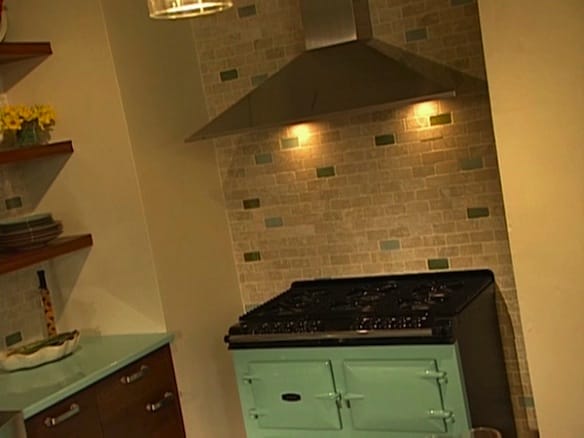
Image credit: DIY Network.
Smoking Out Kitchen Range Hoods
It is a sound that can save your life: the high pitched, insanely loud, impossible-to-ignore BEEP-BEEP-BEEP!of a smoke alarm. When it goes off in the middle of the night because there’s a problem in your furnace, it’s a life saver. When it goes off in the early evening because the shrimp you’re stir-frying are producing too much steam and cooking smoke? That’s just annoying.
Fortunately, there’s a solution that will silence smoke alarms forever, and also keep the smoke, tiny grease particles, and aromas of your cooking endeavors from permeating places in your home where you don’t want them. A kitchen range hood can either vent these substances to outside your dwelling and/or catch them in a special filter. No matter what the style of kitchen range hood, the physics are the same. A fan sucks up airborne smoke, grease, and the tiny particles that cause odors, and send them someplace you want them to be, instead of their permeating your kitchen and beyond. Kitchen range hoods means never having to open a window when you’re broiling steaks ever again.
Vented or Vent-free
Though the physics of the kitchen range hood is similar from model to model, there is a core difference. Some kitchen range hoods are vented. That is, as the whirring fan sucks up the stovetop discharge, the hood directs the discharge into a venting system that ultimately leads outside your dwelling. If the venting system is already installed, that’s great. Otherwise, you’re going to need to factor in venting in your buying decision. If you’re lucky, your kitchen range will back up against an exterior wall, and a venting system will already be in place. If that’s the case, you’re all set for a vented kitchen range hood.
For those folks who aren’t so fortunate, the ventless range hood is your best alternative. These hoods suck up smoke and grease just like vented hoods, but instead of sending it up a vent and out into the atmosphere, the unwanted elements get trapped in a filter. These filters need to be changed every few months. They are usually not recyclable. They are, however, quite inexpensive.
Do note that vented hoods may also have a filtration system in place. Most of the time, these filters are metal, and designed specifically to trap grease. These filters can be cleaned and reused. Also, some hoods may give you the option of venting or filtering. If you have the option of venting? Take it.
Where to Mount Your Hood
The next issue is where to mount your hood. The configuration of your kitchen will often dictate where your hood will go. No matter what mounting system you use, make sure that your hood is big enough for your stovetop. There’s no sense in buying a kitchen hood if it doesn’t have the heft and width to “grab” the particulates you want it to grab.
If you have cabinetry on the wall above your stove, then an under-cabinet hood is a great choice. They latch on to the cabinet, have a small “footprint,” and might even be retractable in a way that can improve the look of your kitchen. Under-cabinet hoods come in both ducted and non-ducted versions.
If you have no cabinetry but still have a conventional range top, you might well be looking at a chimney hood. These range hoods attach to the wall above your stove. They come in both ducted and non-ducted versions, depending on your needs. They tend to have a larger footprint than under-cabinet hoods, but many are quite stylish.
If you have an unconventional stove top, you still have options. For those who are cooking on an “island” range, there are drop-down range hoods that can hang from your ceiling directly above the island. Depending on your system, drop down hoods can even be vented. For those people who for some reason can’t or won’t mount a hood above their cooking area, there are so-called “downdraft” hoods that fit alongside your cooking area and pull smoke and grease downward, to be vented or filtered. They’re not much use with ovens, though.
“Sucking” Power and Noise
Your kitchen range hood needs enough guff to get the job done. You want to make sure it has a powerful enough fan to suck up smoke, grease, and particulates. Range hoods are rated in CFM – cubic feet per minute. That is, how many cubic feet of air can be sucked through in a minute. 350 CFM is a strong rating for a range hood. If you tend to have a lot going on at once on your stovetop, a higher CFM is a plus.
Kitchen range hoods are not quiet. You’ll run yours selectively. They’re rated in something called “sones.” Both your fan and the “whoosh!” of air into the range hood are sources of noise. Two sones are the rough equivalent of the sound of your fridge. Eight or nine sones are loud. You’ll want to balance noise and efficiency. Fortunately, most range hoods come with variable speeds, so you only need to crank it up all the way on selective occasions.
Extra Points
If your kitchen range hood comes with a metal trap for catching grease, check to see that it’s dishwasher safe. Those traps need to be cleaned; the dishwasher can help you do that unpleasant job. Cleaning the trap is not a formality. Grease can gather there, and then drip back down onto your range top. If it hits the wrong place, a grease fire can result.



